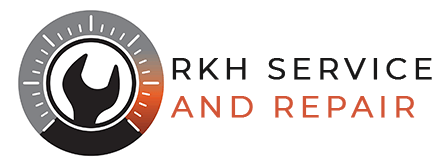Modern cars are packed with technology designed to alert you when something isn’t quite right. But when a warning light flashes or your engine doesn’t sound quite normal, it can be hard to know where to start. That’s where basic car diagnostics and repair come in—helping you identify issues before they become significant (and expensive) problems. Whether you’re a new driver or just looking to understand your vehicle better, this guide will walk you through the essentials.
If you’re based in Ashford, Kent, RKH Service and Repair is your trusted local expert for fast, accurate car diagnostics. With state-of-the-art equipment and a team of skilled technicians, they make it easy to understand what’s going on under the bonnet—without the dealership price tag.
Call us on 01233 877797 or email us at admin@rkhserviceandrepair.co.uk today.
At RKH Service and Repair, we keep your vehicle running smoothly with expert diagnostics and reliable repairs. From pinpointing faults to getting, you back on the road, we deliver honest, high-quality service you can trust—every time.
This vehicle troubleshooting guide will walk you through the key concepts, tools, and steps to diagnose common car issues. You don’t need to be a mechanic—curiosity and the proper knowledge can go a long way.
Why Vehicle Diagnostics Matter
Before exploring the details, it’s essential to understand why diagnostics play a vital role in vehicle maintenance. Modern cars are controlled by an engine control unit (ECU)—essentially the vehicle’s brain. This ECU monitors various systems via sensors and communicates any issues using what are known as diagnostic trouble codes (DTCs).
When something’s wrong, like a failing sensor or a misfiring engine, the car stores a vehicle fault code and often triggers the check engine light.
Reading these codes can point you in the right direction, helping you avoid guesswork and unnecessary repairs.
Understanding Car Fault Codes
Let’s break down the basics of car fault codes. These codes are part of the vehicle onboard diagnostics system (OBD or OBD-II) in vehicles manufactured after 1996.
Each diagnostic trouble code (DTC) combines letters and numbers, such as “P0301”, which refers to a cylinder 1 misfire. The letter indicates the system (P = Powertrain, B = Body, C = Chassis, U = Network), and the numbers provide specific details about the fault.
Some common areas these codes might refer to include:
- Cooling system issues (e.g., faulty thermostat)
- Fuel injectors not working properly
- Low voltage from the car battery
- Faulty readings from the mass air flow sensor
While some codes signal minor problems, others indicate serious issues needing immediate attention.
How To Diagnose Car Problems
Here’s a step-by-step guide:
1. Use An OBD-II Scanner
Invest in a basic OBD-II scanner, a small device plugged into your car’s OBD port, usually under the dashboard. Once connected, it reads the vehicle fault codes stored in the system.
Many modern scanners connect to your smartphone via Bluetooth, offering access to helpful car diagnostic software. Some popular apps even explain what each code means in simple language.
2. Read And Interpret The Codes
Once you have the code, check the meaning in your scanner’s manual or the app. Some common DTCs include:
- P0171 – System too lean (could be related to the mass air flow sensor or a vacuum leak)
- P0300 – Random misfires
- P0128 – Cooling system operating below expected temperature
This will give you a better understanding of what part of the car needs attention.
3. Perform A Visual Inspection
After reading the code, do a basic visual inspection. Look for things like:
- Loose or cracked hoses
- Corroded car battery terminals
- Damaged wires or connectors
- Fluid leaks near the fuel injectors or radiator
This helps confirm whether the issue is something simple you can fix yourself.
4. Decide On Your Next Steps
Not all problems require a trip to the mechanic. Some minor issues—like a loose petrol cap or old spark plugs—can be sorted at home. But it’s best to consult a professional for more serious codes, especially those involving the engine control unit or critical systems like braking.
Helpful Vehicle Maintenance Tips
Prevention is always better than cure. Here are a few simple vehicle maintenance tips to help you avoid common faults:
- Check your car battery every six months, especially before winter.
- Replace your mass air flow sensor if you notice poor acceleration or fuel economy.
- Regularly inspect the cooling system for leaks or low coolant levels.
- Use high-quality fuel and clean fuel injectors as part of your servicing routine.
- Keep your tyres inflated and monitor tread depth.
- Schedule diagnostics every 6–12 months, even if no warning lights show.
Routine maintenance doesn’t just help you avoid breakdowns—it can also improve fuel efficiency and extend the life of your car.
When To Seek Professional Help
While DIY diagnostics can help with simple fixes, there are times when it’s best to leave it to the experts. If your car has:
- Persistent misfires
- Electrical faults
- Transmission issues
- Overheating problems
It’s safer to book an appointment with a trusted mechanic. They can perform complete system diagnostics, including testing sensors and interpreting complex data from the engine control unit.
CONTACT RKH SERVICE AND REPAIR
Final Thoughts
Car diagnostics may initially seem technical, but anyone can get a handle on the basics with the right approach. This vehicle troubleshooting guide has shown you how to recognise the signs, use an OBD-II scanner, and interpret diagnostic trouble codes (DTCs).
If you’re unsure about a warning light on your dashboard or want to stay on top of your vehicle’s health, professional diagnostics can make all the difference.
At RKH Service and Repair, we specialise in accurate, high-quality car diagnostic tests using the latest equipment and technology—all right here in Ashford, Kent. Our experienced team will quickly interpret your results, explain everything, and guide you on any next steps. There is no jargon or guesswork—just honest advice and expert service that beats main dealers for value and customer care.
To book your diagnostic check, call 01233 877797 or email admin@rkhserviceandrepair.co.uk today.
So, next time your dashboard lights up, don’t panic—contact us and let us take charge of your car’s health.



